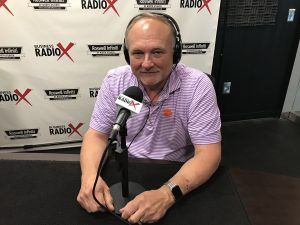

Episode 8, Sleep Apnea, and Two Special Guests from Taylor Road Middle School
Sleep apnea affects not only a partner who can’t sleep for the snoring, but it reduces quality of life for the person affected by this condition. So why does sleep apnea occur, and what are the best treatment options? On this episode of “To Your Heath,” Dr. Jim Morrow addresses these questions and more, and talks about his own experience with sleep apnea.
Also in this episode, Dr. Morrow welcomes two 8th grade students from Taylor Road Middle School in Johns Creek, Cion Kim and Ananya Shaeker. To complete a project assignment for their language arts class, Cion and Ananya used a previous episode of “To Your Health” to explore the dangers of vaping for their peers. Impressed by their work, Dr. Morrow was delighted to welcome Cion and Ananya to the show!


Dr. Morrow’s Show Notes on Sleep Apnea
Sleep Apnea
- There are two kinds of sleep apnea: obstructive apnea and central apnea.
- Obstructive sleep apnea is the most common type.
- Nine out of 10 people who have sleep apnea have this type of apnea.
- something is blocking the airway that brings air into your body (also called the trachea).
- When you try to breathe, you can’t get enough air because of the blockage. Your airway might be blocked by your tongue, tonsils, or uvula (the little piece of flesh that hangs down in the back of your throat).
- It might also be blocked by a large amount of fatty tissue in the throat or by relaxed throat muscles.
- Central sleep apnea is less common. This type of sleep apnea is related to the function of the central nervous system. If you have this type of apnea, the muscles you use to breathe don’t get the “go-ahead” signal from your brain. Either the brain doesn’t send the signal, or the signal gets interrupted.
Obstructive Sleep Apnea
- Obstructive sleep apnea is a common disorder that causes patients to temporarily stop or decrease their breathing repeatedly during sleep.
- People who have sleep apnea stop breathing for 10 to 30 seconds at a time while they are sleeping.
- These short stops in breathing can happen up to 400 times every night.
- If you have sleep apnea, periods of not breathing can disturb your sleep (even if they don’t fully wake you up).
- This results in fragmented, non-restful sleep that can lead to symptoms such as morning headache and daytime sleepiness.
- Obstructive sleep apnea affects persons of all ages, especially:
- Men,
- people who are overweight, and
- people who are older than 40 years of age are more likely to have sleep apnea.
- However, it can affect anyone at any age.
- There are many health conditions associated with obstructive sleep apnea, including
- hypertension,
- coronary artery disease,
- cardiac arrhythmias, and
- depression
- Predictive clinical features are:
- Loud snoring,
- gasping during sleep,
- obesity, and
- enlarged neck circumference.
- Screening questionnaires can be used to assess for sleep apnea, although their accuracy is limited.
- The diagnostic standard for obstructive sleep apnea is nocturnal polysomnography in a sleep laboratory (a sleep study).
- Home sleep apnea tests are available and in recent years have become more reliable.
- Home portable monitoring can be used as a substitute for in-laboratory polysomnography for the diagnosis of OSA in patients with a high likelihood of SA.
- Most patients prefer home monitoring, and clinical outcomes among patients diagnosed by either method are comparable regarding sleepiness, sleep-related quality of life, and compliance with continuous positive airway pressure (CPAP) therapy
What is the Result of Untreated Obstructive Sleep Apnea?
Relation to Hypertension
- About one half of patients who have essential hypertension have obstructive sleep apnea, and
- About one half of patients who have obstructive sleep apnea have essential hypertension.
- A growing body of evidence suggests that obstructive sleep apnea is a major contributing factor in the development of essential hypertension.
Excessive Daytime Sleepiness
- Excessive daytime sleepiness is one of the most common sleep-related patient symptoms
- affects an estimated 20 percent of the population. Persons with excessive daytime sleepiness are at risk of motor vehicle and work-related incidents, and have poorer health than comparable adults.
- The most common causes of excessive daytime sleepiness are sleep deprivation, obstructive sleep apnea, and sedating medications.
- Other potential causes of excessive daytime sleepiness include certain medical and psychiatric conditions and sleep disorders, such as narcolepsy.
- Obstructive sleep apnea is a particularly significant cause of excessive daytime sleepiness.
- An estimated 26 to 32 percent of adults are at risk of or have obstructive sleep apnea, and the prevalence is expected to increase.
- The evaluation and management of excessive daytime sleepiness is based on the identification and treatment of underlying conditions (particularly obstructive sleep apnea), and the appropriate use of activating medications.
Connection to Heart Disease
- The connection between sleep apnea and heart disease is evolving very rapidly.
- People with cardiovascular problems such as high blood pressure, heart failure, and stroke have a high prevalence of sleep apnea.
- Whether sleep apnea actually causes heart disease is still unclear, but we do know that if you have sleep apnea today, the chance that you will develop hypertension in the future increases significantly.
- One of the problems in defining the relationship between sleep apnea and heart disease is that people with sleep apnea often have other co-existing diseases as well.
- If you treat people with high blood pressure and sleep apnea, or heart failure and sleep apnea, the measures of blood pressure or heart failure are significantly improved. There is good evidence to think there is a cause-and-effect relationship between hypertension and sleep apnea.
- Why does your blood pressure go up when your sleep is disrupted by sleep apnea?
- Your blood pressure will go up because when you’re not breathing, the oxygen level in your body falls and excites receptors that alert the brain. In response, the brain sends signals through the nervous system and essentially tells the blood vessels to “tighten up” in order to increase the flow of oxygen to the heart and the brain, because they have priority.
- The problem is that things that go on at night tend to carry over in the daytime, even when the sleep apnea patient is awake. The low oxygen levels at night seem to trigger multiple mechanisms that persist during the daytime, even when the patient is breathing normally.
- How can CPAP (continuous positive airway pressure) reduce the cardiovascular consequences of sleep apnea?
- The available evidence tells us that when you treat people with sleep apnea using CPAP, their blood pressure is not only lower at night—it’s also lower during the day. That’s a very good thing.
- Moreover, people with atrial fibrillation (a common type of irregular heart beat) with sleep apnea that is appropriately treated have only a 40% chance of coming back for further treatment of their atrial fibrillation.
- If their sleep apnea is untreated, the chance of a recurrence of atrial fibrillation goes up to 80%. The message to heart patients with sleep apnea is: With treatment of your sleep apnea, your chances of improvement are considerably better.
Can Sleep Apnea Be Prevented or Avoided?
- There are things you can do to prevent sleep apnea. The following steps help many people:
- Stop all use of alcohol or sleep medicines. These relax the muscles in the back of your throat, making it harder for you to breathe.
- If you smoke, quit smoking.
- If you are overweight, lose weight.
- Sleep on your side instead of on your back.
About Morrow Family Medicine and Dr. Jim Morrow
Morrow Family Medicine is an award-winning, state-of-the-art family practice with offices in Cumming and Milton, Georgia. The practice combines healthcare information technology with old-fashioned care to provide the type of care that many are in search of today. Two physicians, three physician assistants and two nurse practitioners are supported by a knowledgeable and friendly staff to make your visit to Morrow Family Medicine one that will remind you of the way healthcare should be. At Morrow Family Medicine, we like to say we are “bringing the care back to healthcare!” Morrow Family Medicine has been named the “Best of Forsyth” in Family Medicine in all five years of the award, is a three-time consecutive winner of the “Best of North Atlanta” by readers of Appen Media, and the 2019 winner of “Best of Life” in North Fulton County.

Dr. Jim Morrow is the founder and CEO of Morrow Family Medicine. He has been a trailblazer and evangelist in the area of healthcare information technology, was named Physician IT Leader of the Year by HIMSS, a HIMSS Davies Award Winner, the Cumming-Forsyth Chamber of Commerce Steve Bloom Award Winner as Entrepreneur of the Year and he received a Phoenix Award as Community Leader of the Year from the Metro Atlanta Chamber of Commerce. He is married to Peggie Morrow and together they founded the Forsyth BYOT Benefit, a charity in Forsyth County to support students in need of technology and devices. They have two Goldendoodles, a gaggle of grandchildren and enjoy life on and around Lake Lanier.
Facebook: https://www.facebook.com/MorrowFamMed/
LinkedIn: https://www.linkedin.com/company/7788088/admin/
Twitter: https://twitter.com/toyourhealthMD














